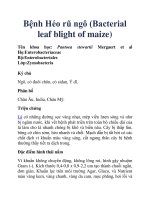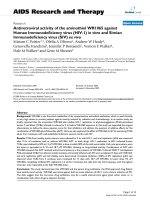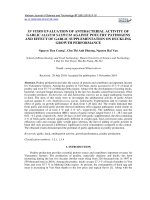Screening of promising sorghum genotypes against turcicum leaf blight (Exserohilum turcicum (Pass.) Leonard and Suggs) under glasshouse conditions
Bạn đang xem bản rút gọn của tài liệu. Xem và tải ngay bản đầy đủ của tài liệu tại đây (191.66 KB, 4 trang )
Int.J.Curr.Microbiol.App.Sci (2019) 8(5): 655-658
International Journal of Current Microbiology and Applied Sciences
ISSN: 2319-7706 Volume 8 Number 05 (2019)
Journal homepage:
Original Research Article
/>
Screening of Promising Sorghum Genotypes against Turcicum Leaf Blight
(Exserohilum turcicum (Pass.) Leonard and Suggs) under Glasshouse
Conditions
Raghavender Yelgurty1*, S.K. Jayalkshmi2, B. Zaheer Ahamed3,
Shreedevi S. Chavan4 and G. Girish4
1
Department of Plant Pathology, College of Agriculture,
University of Agricultural Sciences, Raichur-584104, Karnataka, India
2
Department of Plant Pathology, College of Agriculture,
Kalaburagi – 585101, Karnataka, India
3
Department of Plant Pathology, ICAR-Krishi Vigyan Kendra, Kalaburagi – 585101,
Karnataka, India
4
Department of Genetics and plant breeding, College of Agriculture, University of
Agricultural Sciences, Raichur-584104, Karnataka, India
*Corresponding author
ABSTRACT
Keywords
Sorghum, Turcicum
leaf blight,
Screening,
Exerohilum
turcicum
Article Info
Accepted:
10 April 2019
Available Online:
10 May 2019
Sorghum (Sorghum bicolor Linn. Moench) popularly known as Jowar, is the
major cereal consumed in India and ranks fifth after wheat, rice, maize and pearl
millet. A total of 23 sorghum genotypes were screened for their reaction against
turcicum leaf blight under glass house condition. Out of 23 genotypes screened,
four showed resistant reaction (Grade-2) viz., J-P-1-5, J-9, IS-2312 and C-42.
Whereas M 35-1, J-33, J-3-1, J-4-1, Chincholli, GS-23, E-36-1, J-35, C-35, J-9-12,
J-6-2, J-11, C-30, J-8 and C-28 showed moderately resistant reaction (Grade-3)
and remaining four genotypes viz., DSV-4, SPV-86, DJ-6514, H-112 recorded
susceptible reaction (Grade-4).
maize and pear millet cultivated in 6.16
million hectares in both kharif (2.26m.ha) and
rabi (3.89m.ha) with an annual production of
5.44 million tons of grain with productivity of
8.44 kg per hectare (INDIASTAT, 2015).
Introduction
Sorghum (Sorghum bicolor Linn. Moench)
popularly known as Jowar, is the major cereal
consumed in India and ranks fifth after wheat,
rice, maize and pearl millet. The world
production of grain sorghum is 70.83 million
tons from 44.8 million ha area of land
(FAOSTAT, 2014). India is major producer
of sorghum, ranks fifth after, wheat, rice,
In India the sorghum is cultivated in
Maharashtra, Karnataka and Andhra Pradesh
as rainfed crop to an extent of 85 per cent
(4.93m.ha). In Karnataka sorghum production
655
Int.J.Curr.Microbiol.App.Sci (2019) 8(5): 655-658
is about 1.32 million tons in an area of 1.04
million ha with the average productivity of
1180 kg per ha. The sorghum is the main food
crop of Hyderabad-Karnataka region and
occupies an area of 5.6 lakh hectares with
production of 5.5 lakh tons and productivity
of 1122kg per ha (Anon., 2014-15).
the most destructive foliar diseases of maize
and sorghum. It can cause yield reduction
more than 50 % in susceptible varieties and is
favoured by mild temperatures and humid
weather conditions with heavy dews
(Bergquist, 1986). The disease occurs as long
elliptic tan lesions that develop on lower
leaves and progress upwards. Susceptibility to
Exserohilum turcicum is reported to decrease
with crop maturity (Frederiksen, 1980).
As the rabi sorghum produces the white
pearly grains which is mainly used for food in
India for the preparation of roti. It is also an
important animal feed (swine, poultry and
cattle) used in countries like U.S., Mexico,
South America and Australia. Sorghum, as a
food, feed and bio fuel crop with excellent
drought resistance compared to other cereals,
is considered as a “failsafe crop” (Burke et
al., 2010).
Most of the composites and hybrids which are
being grown on commercial scale are found to
be more or less susceptible to TLB. Host plant
resistance is considered as most practical,
feasible and economical method of plant
disease management. Hence, screening of
promising
sorghum
genotypes
was
undertaken under artificial inoculated
conditions to identify source of resistance.
Sorghum grain is a principal source of energy,
protein, vitamins and minerals for the poor
people living in the semi-arid tropics. It is
nutritionally superior to rice because of its
high mineral and fiber content. Starch (6075%) is the main component of sorghum
grain, followed by proteins (7-15%), nonstarch polysaccharides (2-7%) and fat (1.56%).The average energetic value of whole
sorghum grain flour is 356 kcal/100gm
(Dicko et al., 2006). Sorghum is a good
source of vitamins, notably the B vitamins
(thiamin, riboflavin, pyridoxine and niacin)
and the liposoluable vitamins A, D, E and K.
Unique property of sorghum grain makes it
well suited to prepare various food items such
as porridge, unleavened bread, cookies, cakes,
couscous and malted beverages, etc.
Materials and Methods
Nearly 23 promising sorghum genotypes were
screened under glasshouse conditions by
using Pot culture technique (Greenhouse
screening technique).
Inoculum preparation
The fungal isolate was grown in potato
dextrose broth in a rotary shaker (25°C, 125
rpm, with cool light) for 10 days. Conidia
were separated from mycelial mat and
medium by filtering the cultures through
double-layered muslin cloth, and spore was
adjusted to concentration (1×105 conidia
mL-1) with the help of haemocytometer. Two
drops of Tween-20TM was added to 100 ml
inoculum just before inoculation.
Even though the crop is robust and versatile,
it has faced drawbacks in terms of yield and
reduction in acreage due various diseases. The
major diseases that affect sorghum include
downy mildew, turcicum leaf blight,
anthracnose and sorghum smuts (covered
kernel smut, loose smut, long smut and head
smuts). Turcicum leaf blight (TLB) is one of
Inoculation
Inoculum was sprayed on 21-days old plants
raised in pots using a hand-held atomizer. The
inoculated plants were air dried and
656
Int.J.Curr.Microbiol.App.Sci (2019) 8(5): 655-658
transferred to a humid chamber for 24 h. Five
plants/pot with 3 replications were maintained
for each genotype. The plants were
transferred to greenhouse benches and the
pots were arranged in a complete randomized
design and regular watering was provided to
maintain high humidity. Data was recorded on
latent period (time in days for the appearance
of first chlorotic/necrotic lesion) starting the
4th day after inoculation on each genotype.
Data was recorded for disease reaction types
and disease severity on (1 to 5 scale) as
described below (Thakur et al., 2007) 14 days
after inoculation.
Results and Discussion
A total of 23 sorghum genotypes were
screened for their reaction against turcicum
leaf blight under glass house condition.
Table.1 Disease severity (1-5 scale) against E. turcicum (Thakur et al., 2007)
Severity Rating
1
2
3
4
5
Symptom and lesion types (on top four leaves)
No visible symptoms/chlorotic
Flecks
Up to 10% leaf area covered
with small restricted lesions
11−25% leaf area covered with small restricted lesions
26−50% leaf area covered with large coalescing lesions
>50% leaf area covered with large coalescing lesions
Reaction type
Highly resistant (HR)
Resistant (R)
Moderately resistant (MR)
Susceptible (S)
Highly susceptible (HS)
Table.2 Reaction of sorghum genotypes against E. turcicum under glasshouse conditions
SL.N0
1
2
3
4
5
6
7
8
9
10
11
12
13
Genotypes
J-6-2
J-4-1
J-9-12
J-9
J-35
J-33
C-38
C-35
C-42
C-28
J-11
J-8
J-3-1
14
15
16
17
18
19
20
21
22
23
GS-23
Chincholli
DSV-4
E-36-1
J-P-1-5
DJ-6514
SPV-86
IS-2312 (Resistant Check)
H-112 (Susceptible check)
M 35-1
Grade
3
3
3
2
3
3
3
3
2
3
3
3
3
Reaction
MR
MR
MR
R
MR
MR
MR
MR
R
MR
MR
MR
MR
3
3
4
3
2
4
4
2
4
3
MR
MR
S
MR
R
S
S
R
S
MR
Checks
R-Resistant, MR-Moderately resistant, S-Susceptible
657
Int.J.Curr.Microbiol.App.Sci (2019) 8(5): 655-658
The results reveals that, Out of 23 genotypes
screened, four showed resistant reaction
(Grade-2) viz., J-P-1-5, J-9, IS-2312 and C42. Whereas M 35-1, J-33, J-3-1, J-4-1,
Chincholli, GS-23, E-36-1, J-35, C-35, J-912, J-6-2, J-11, C-30, J-8 and C-28 showed
moderately resistant reaction (Grade-3) and
remaining four genotypes viz., DSV-4, SPV86, DJ-6514, H-112 recorded susceptible
reaction
(Grade-4)
indicating
their
susceptibility for TLB under glasshouse
condition (Table 1 and 2).
green drought tolerance trait in
sorghum germplasm. Agron. J., 102:
1118-1122.
Dicko, M.H., Gruppen, H., Zouzouho, O. C.,
Traore. A. S., Berkel, W. J. and
Voragen, A. G. J., 2006, Effect of
germination
on
amylases
and
phenolics related enzymes in fifty
sorghum verities grouped according to
food-end use properties. J. Sci. Food
Agric., 86:130-143.
Frederiksen, R.A., 1980. Sorghum leaf blight.
In Proceedings of the International
Workshop on Sorghum Diseases: 1115 Dec. 1978, Hyderabad, ICRISAT,
Patancheru, A.P. 502324, India. pp.
243-248.
FAOSTAT, 2014, World Sorghum production
and utilization. FAO Rome. Available
on
./
foodgrains.
INDISTSAT 2015, India sorghum production
and utilization. New Delhi. Available
on
/>culture/2/foodgrains/17180/jowargreat
millet.
Thakur, R.P., Reddy, B. V. S. and Mathur, K.,
2007, Screening techniques for
sorghum
diseases.
Information
Bulletin No. 76. International Crops
Research Institute for the Semi-Arid
Tropics. 92 pp.
Vaibhav, S., and Yogendra, S., 2014,
Screening of germplasm against
Exserohilum leaf blight. Indian
Journal Of Animal Nutrition, 7(16):
2087-2089.
These are in agreement with results obtained
by earlier workers (Vaibhav and Yogendra
2014) while working with turcicum leaf blight
of sorghum who found 39 germplasms
showed resistant reaction which included SPV
2019, SPV 2024, SPH 1653, SPV 2020 and
SPV 2021; 43 showed moderately resistant
reaction while 11 were recorded as
susceptible. Moderately resistant germplasms
included SPV 1822, SPV 2011, CSH 23, SPV
1871, SPV 2027 and SPV 2010.
References
Anonymous,
2014-15,
Directorate
of
Economics and Statistic Bengaluru.
High power committee report. pp: 6874.
Bergquist, R., 1986., Leaf blight, In:
Compendium of Sorghum Diseases.
American Phytopathological Society.,
48:56-58.
Burke, J.J., Franks, C.D., Burrow, G. and Xin.
Z. 2010. Selection system for the stay
How to cite this article:
Raghavender Yelgurty, S.K. Jayalkshmi, B. Zaheer Ahamed, Shreedevi S. Chavan and Girish,
G. 2019. Screening of Promising Sorghum Genotypes against Turcicum Leaf Blight
(Exserohilum turcicum (Pass.) Leonard and Suggs) under Glasshouse Conditions.
Int.J.Curr.Microbiol.App.Sci. 8(05): 655-658. doi: />
658









